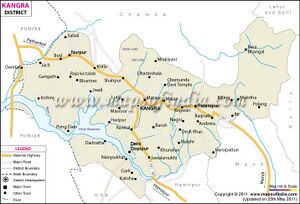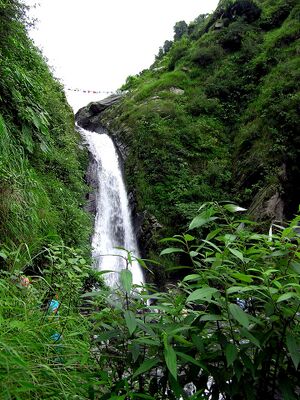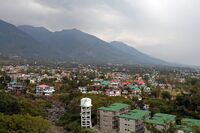Dharamshala
| Author:Laxman Burdak, IFS (R) |


Dharamshala (धर्मशाला) is the winter capital city of Himachal Pradesh, India. It is located in Kangra district and is its headquarter.
Location
It is located in Kangra district. Dharamshala has an average elevation of 1,457 metres (4,780 ft), covering an area of almost 8.51 km2 (3.29 sq mi). Dharamsala is located in the Kangra Valley, in the shadow of the Dhauladhar mountains.
Variants
Villages in Dharmshala tahsil
Towns: 1 Dharmsala, Sarah Dharmsala, 2 Yol,
Villages : 1 Andrar, 2 Anjani, 3 Baghni, 4 Bagiarra, 5 Bagli, 6 Bahl, 7 Balehr Khas, 8 Balla, 9 Balreh , 10 Bandi Khas, 11 Bandi Khurd, 12 Bangrehr, 13 Banwala, 14 Bara Khola, 15 Barnet, 16 Barwala Khas, 17 Bhadrolu, 18 Bhatala, 19 Bhatehr, 20 Bhatehr, 21 Bhitlu, 22 Braih, 23 Buhli Tangroti, 24 Chakban Banwala, 25 Chakban Dugbar, 26 Chakban Ghanyara, 27 Chakban Gharo, 28 Chakban Ghiana Kalan, 29 Chakban Kardiana, 30 Chakban Sudehd, 31 Chamiara, 32 Chelian, 33 Chetru, 34 Chhainti, 35 Chhatair, 36 Chhatair, 37 Chhawani, 38 Chohla, 39 Dehru, 40 Dhar, 41 Dhial, 42 Diara, 43 Diktu, 44 Dudehr, 45 Dughwar Khas, 46 Dungla, 47 Gabli Dar, 48 Gamrehr, 49 Garh, 50 Garh, 51 Ghaihr, 52 Ghana, 53 Ghanyara Khas, 54 Gharoh Khas, 55 Gharopura, 56 Gharthehar, 57 Gharthina, 58 Ghartholi, 59 Ghiana Kalan, 60 Ghiana Khurd, 61 Gujrehra, 62 Gulerian, 63 Harnehr, 64 Hodal, 65 Jamli, 66 Jasyal, 67 Jatehr, 68 Jatehr, 69 Jhakrehr, 70 Jhikkar, 71 Jhikla Odar, 72 Jhikli Dar, 73 Juhl, 74 Jule, 75 Kajlot -I, 76 Kajlot -II, 77 Kaland Rehr, 78 Kand, 79 Kand, 80 Kardiana, 81 Kareri Khas, 82 Kasba, 83 Khari Behi, 84 Kharota, 85 Khatehr, 86 Kotla, 87 Kuliara, 88 Kumharkar, 89 Kut, 90 Kutharna, 91 Lanjhni, 92 Loharkar, 93 Machhan, 94 Mandal, 95 Maned, 96 Masrehr, 97 Mat, 98 Meti, 99 Miniana, 100 Mohli Harandi, 101 Mohli Lahrandi, 102 Mowa, 103 Naddi, 104 Nagan Pat, 105 Narghota, 106 Narwana, 107 Nauhali, 108 Nora, 109 Padar, 110 Padher, 111 Palotha, 112 Pandtehr, 113 Panjlehr, 114 Parol, 115 Pat, 116 Patani, 117 Patohla, 118 Patohla , 119 Rakar, 120 Rasan, 121 Rasehr, 122 Rawa, 123 Ruhru, 124 Sail, 125 Sakoh, 126 Salag, 127 Ser, 128 Sheehla, 129 Sidhbari, 130 Sidhpur, 131 Sokani Da Kot, 132 Sudehd Khas, 133 Sukar Khas, 134 Swala, 135 Tahu , 136 Tangh, 137 Tangroti, 138 Tangroti Khas, 139 Taremlu, 140 Thamba, 141 Thatri, 142 Thehr, 143 Tikri, 144 Upahu, 145 Uparli, 146 Uparli Dar, 147 Uperla Sukar, 148 Uperli Bhadwal, 149 Upperla Odar, 150 Uprer, 151 Uthargaran,
Source - https://www.census2011.co.in/data/subdistrict/99-dharmsala-kangra-himachal-pradesh.html
History
It has served as the location for the administrative headquarters of the Kangra district after they were relocated from Kangra, a city located 18 kilometres away from Dharamshala, in 1855.
Dharamshala is a municipal corporation city in the upper reaches of the Kangra Valley and is surrounded by dense coniferous forest consisting mainly of stately Deodar cedar trees. The suburbs include McLeod Ganj, Bhagsunag, Dharamkot, Naddi, Forsyth Ganj, Kotwali Bazar (the main market), Kaccheri Adda (government offices such as the court, police, post, etc.), Dari, Ramnagar, Sidhpur, and Sidhbari (where the Karmapa is based).
The McLeod Ganj town, lying in the upper reaches, is known worldwide for the presence of the Dalai Lama.[1] On 29 April 1959, the 14th Dalai Lama (Tenzin Gyatso) established the Tibetan exile administration in the north Indian hill station of Mussoorie.[2] In May 1960, the Central Tibetan Administration (CTA) was moved to Dharamshala, making it the centre of the Tibetan exile world in India. Following the 1959 Tibetan uprising there was an influx of Tibetan refugees who followed the 14th Dalai Lama. His presence and the Tibetan population have made Dharamshala a destination for Indian and foreign tourists, including students studying Tibet.
Although majority of tea gardens in Kangra District are located in and around Palampur, Dharamshala also has several tea gardens which are prominently around Sheela Chowk and extend northwards to Khaniyara. The other tea gardens are at Kunal Pathri. The tea is known as Dharamsala or Kangra tea, is very popular across India and the rest of the world.[3] Traditionally known for Kangra green tea, Dharamshala now produces all teas including black tea, green tea, oolong tea and white teas, in addition to the popular Kashmiri Kahwa and Masala Chai.
Until the British Raj, Dharamshala and its surrounding area was ruled by the Katoch Dynasty of Kangra, a royal family that ruled the region for two millennia. New findings by researchers suggest "the Katoch dynasty dates back to 8,000 years and its 300 rulers ruled in the pre-Mahabharata period and the present scion of this clan, Aditya Dev Katoch, is the 488th member of the clan in the lineage" The researchers claimed "this dynasty is not only the oldest ruling clan of India but also the oldest dynasty of the world and its founder, Adipursha, had come from Mongolia about 11,000 years back"."[4] The royal family still keeps a residence in Dharamsala, known as 'Clouds End Villa'. Under the British Raj, the regions were part of undivided province of Punjab, and was ruled by the governors of Punjab from Lahore. The Katoch dynasty, although highly regarded culturally, had been reduced to status of jagirdars (of Kangra-Lambagraon) under the Treaty of Jawalamukhi, signed in 1810 between Sansar Chand Katoch and Maharaja Ranjit Singh of Punjab.
The indigenous people of the Dharamshala area (and the surrounding region) are the Gaddis, a predominantly Hindu group who traditionally lived a nomadic or semi-nomadic transhumant lifestyle.[5] Due to the lack of permanent settlements in the area, some Gaddis lost their seasonal pastures and farmland when the British and the Gurkhas arrived to settle.
Settlement by the British and the Gurkhas: In 1848, the area now known as Dharamshala was annexed by the British. ..."Dharamsāla lies on a spur of the Dhola Dhār, 16 miles north-east of Kāngra, in the midst of wild and picturesque scenery. It originally formed a subsidiary cantonment for the troops stationed at Kāngra, and was first occupied as a station in 1849, when a site was required for a cantonment to accommodate a Native regiment which was being raised in the District. A site was found upon the slopes of the Dhola Dhār, in a plot of waste land, upon which stood an old Hindu resthouse, or dharmsāla, whence the name adopted for the new cantonment. The civil authorities, following the example of the regimental officers, and attracted by the advantages of climate and scenery, built themselves houses in the neighbourhood of the cantonment; and in 1855 the new station was formally recognised as the headquarters of the Kāngra District."[6]
In 1860, the 66th Gurkha Light Infantry was moved from Kangra, Himachal Pradesh to Dharamshala, which was at first made a subsidiary cantonment. An ideal position for the new base was found on the slopes of the Dhauladhar Hills, near the site of a Hindu sanctuary, or Dharamshala, hence the name of the town.[7] The Battalion was later renamed the historic 1st Gurkha Rifles, this was the beginning of the legend of the Gurkhas, also known as the 'Bravest of the Brave'. Consequently, fourteen Gurkha platoon villages grew from this settlement, and exist to this day, namely Dari, Ramnagar, Shyamnagar, Dal, Totarani, Khanyara, Sadher, Chaandmaari, Sallagarhi, Sidhbari, Yol, and so on. The Gurkhas worshipped at the ancient Shiva temple of Bhagsunag. The Gurkhas referred to Dharamshala as Bhagsu and referred to themselves as Bhagsuwalas.
The 21st Gurkha Regiment from Dharamshala performed heroic feats during World War I and the North West Frontier Province campaigns. The Gurkha cantonment then reached its zenith during World War II, when battalions from Dharamshala made history. Many place names in the town still retain their former cantonment terminologies: Depot Bazaar, Pensioners' Lines, Tirah Lines (named after the 19th century Tirah Campaign), Bharatpore Lines (named after the 1826 Battle of Bharatpore).
The eighth earl Lord Elgin, Viceroy of India died here (at the 1st Gurkha Rifles Officers' Mess) in 1863 and is buried in the cemetery of St. John in the Wilderness, a small Anglican church distinguished by its stained-glass windows. Dharamshala became a popular hill station for the British working in or near Delhi, offering a cool respite during the hot summer months.
"Before the earthquake of 1905, the upper part of the station, which rises to a height of 7,112 feet [2,168 metres], contained the European houses, the station church, and the officers' mess and lines of the 1st Gurkhas, together with the public gardens, post office, and two bazars, the Forsyth Ganj and McLeod Ganj. The public offices, a bazar, and a few European houses made up the lower station, as low as 4,500 feet [1,372 metres]. The 1st battalion of the 1st Gurkhas used to be stationed here, but was moved to the upper station in 1894-5.... The public gardens, which were, before the earthquake, laid out with much taste in lawns and terraces, contained a valuable collection of indigenous and imported trees and shrubs, and were overlooked by the Assembly Rooms, a handsome building comprising a public hall, a library and reading-room and a billiard-room. The church was beautifully situated in a recess of the mountain."[8]
In 1905, the Kangra valley suffered a major earthquake. On 4 April of that year, the earth shook, demolishing much of the cantonment and the neighbouring city of Kangra, Himachal Pradesh as well as the Bhagsunag temple. Altogether, the 1905 Kangra earthquake killed 20,000 people. "1,625 persons perished at Dharamsāla alone, including 15 Europeans and 112 of the Gurkha garrison."[9]
The Gurkhas rebuilt the town along with the temple, which today is acknowledged as the 1st Gurkha Rifles' heritage. The British had planned to make Dharamshala the summer capital of India, but moved to Shimla after the disaster.
Not only did the Gurkhas of Dharmshala make a major contribution to India's defence, many were freedom fighters for the Indian National Army, which had been founded by Netaji Subhas Chandra Bose. The Indian National Army Captain Ram Singh Thakur, a Gurkha from the village of Khanyara, composed some of India's most popular and stirring patriotic songs, including "Kadam Kadam Badaye Ja". He is acknowledged so by the Netaji Research Bureau, Kolkata. The important contribution of the noted Gurkha social commentator, the late Master Mitrasen Thapa, from the village of Totarani, has been acknowledged by the Himachal Pradesh government. Recently, a park dedicated to the memory of the late Brigadier Sher Jung Thapa, MVC, the 'Hero of Skardu', has been opened alongside the road between Lower and Upper Dharamshala.
Establishment of Tibetan exile community: The Tibetan settlement of Dharamshala began in 1959, when the Dalai Lama had to flee Tibet and Jawaharlal Nehru, the then Prime Minister of India allowed him and his followers to settle in McLeod Ganj, a former colonial British summer picnic spot 10 Kilometers to the north of Dharamshala. "Nehru was delighted with the 'forgotten ghost-town wasting in the woods', and offered it to the Dalai Lama."[10] There they established the "government-in-exile" in 1960 and the Namgyal Monastery. Dharamshala had been connected with Hinduism and Buddhism for a long time, many monasteries having been established there in the past, by Tibetan immigrants in the 19th century.
In 1970, Tenzin Gyatso, the 14th Dalai Lama opened the Library of Tibetan Works and Archives[11] which houses over 80,000 manuscripts and other important resources related to Tibetan history, politics and culture. It is considered one of the most important institutions for Tibetology in the world, the new director is Geshe Lahkdor, the old translator of the Dalai Lama.
Nagavanshi History
Dr Naval Viyogi[12] writes....Most probably Nagas moved from Kashmir valley and settled in different valleys of Himachal Pradesh. Still today these Nagas can be Seen in numerous temples and heard in legends throughout the modern province of Himachal Pradesh.
There is also another Naga in Chamba state called Indru Naga. This is the same as Nahusha whose story is told in the Mahabharata. Indru Naga is worshiped at several paces : at Kuārsi on the road leading to Dharmasala, at Samra in Ranhun kothi, at Chinota and Trehta. There is also another temple of Indru Naga at Kanhiarā in Kangra. [13]
धर्मशाला

धर्मशाला (Dharamshala) भारत के हिमाचल प्रदेश राज्य के काँगड़ा ज़िले में स्थित एक नगर है। यह ज़िले का मुख्यालय भी है। धर्मशाला राज्य की शीतकालीन राजधानी है। यह कांगड़ा नगर से 16 किमी की दूरी पर स्थित है। धर्मशाला के मैक्लॉडगंज उपनगर में केंद्रीय तिब्बती प्रशासन के मुख्यालय हैं, और इस कारण यह दलाई लामा का निवास स्थल तथा निर्वासित तिब्बती सरकार की राजधानी है।
इतिहास: काँगड़ा क्षेत्र में ब्रिटिश राज के आगमन से पहले धर्मशाला और इसके आस पास के क्षेत्रों में दो सहस्राब्दियों तक कटोच राजवंश का शासन था। 1810 में महाराजा रणजीत सिंह तथा कटोच राजा संसारचन्द्र कटोच के मध्य हुई ज्वालामुखी की संधि के बाद कटोच केवल काँगड़ा क्षेत्र में स्थानीय जागीरदार रह गए। 1848 में क्षेत्र पर अंग्रेज़ों ने कब्ज़ा कर लिया था। 1849 में कांगड़ा जिले के अंदर एक फौजी छावनी के लिए धौलाधार पर्वत की ढलानों पर एक स्थान को चुना गया, जहां एक हिन्दू धर्मशाला स्थित थी।
धर्मशाला का नगर वर्ष 1849 में कांगड़ा में स्थित सैन्य छावनी के लिए अस्तित्व में आया। वर्ष 1855 में धर्मशाला को कांगड़ा जिले का मुख्यालय घोषित किया गया था। 1896 में धर्मशाला में बिजली भी लोगों मिलनी शुरू हुई थी। तत्पश्चात नगर में कार्यालयों के विकास के अतिरिक्त व्यापार व वाणिज्य, सार्वजनिक संस्थान, पर्यटन सुविधाओं तथा परिवहन गतिविधयों में भी उन्नति हई। वर्ष 1905 व् 1986 के भूकम्पों से नगर का बहुत नुकसान हुआ। 1960 से महामिहम दलाई लामा का मुख्यालय भी धर्मशाला में स्थित है।
भूगोल: धौलाधार के उभरे हुए खण्ड पर स्थित इस नगर से सम्पूर्ण कांगड़ा घाटी दिखाई पड़ती है। धर्मशाला का उत्तरी भाग हरे जंगलों से घिरा हुआ है, पश्चिम में ढलानदार कृषि के खेत हैं, तथा पूर्व व दक्षिण में धौलाधार की सम्मोहक घाटयों के शीर्ष पर विकास हुआ है। शहर मुख्य जीवनदायिनी सड़को के साथ - साथ तेजी से फैल रहा है। पहाड़ की तरफ भौतिक-भौगोलिक रूकावटों के कारण नगर का विकास सामान्यतः घाटी की तरफ हो रहा है। भूगर्भ शास्त्रानुसार यह नगर भूकम्प सम्बन्धी पट्टिका संख्या -४ की दोषपूर्ण रेखा के निकट पड़ता है, जो भूकम्प प्रवृत्तियुक्त क्षेत्र है। हिमालय के बीच में धौलाधार पर्वत श्रंखला के धरातल पर स्थित सामान्यतः इसकी तलछटी चट्टानें है। ऊपरी तह संगिठत रेत, बाढ़ की जमी हुई मिट्टी व गोल चिकने कंकरो का मिश्रण है, जो चट्टानों के आधार पर टिकी है ।
पर्यटन: धर्मशाला तिब्बती शरणार्थियों का निवास-स्थान है। यह नगर ऐतिहासिक डल झील, खनियारा व कंजार महादेव मेले के लिए जाना जाता है। भागसूनाग, कुणाल पत्थरी व चिन्मन्या जैसे हिन्दुओं के मन्दिर यहां या नगर के निकट स्थित हैं। चामुण्डा देवी, कांगडा का बृजेशवरी, ज्वालामुखी व चिन्तपूर्णी मंदिर भी नगर के पड़ोस में स्थित है। उपरोक्त धार्मिक स्थलों के अतिरिक्त यह पालमपुर, शोभा सिंह आर्ट गैलरी, अन्दरेटा व वैजनाथ के पर्यटन स्थलों के लिए भी आधार शिविर का कार्य करता है।
Notable persons
- Sarbjit Pinka (सर्बजीत पिंका): स्मार्ट सिटी धर्मशाला के रहने वाले सर्बजीत मलूहिया उर्फ पिंका समाजसेवा में बड़ा नाम हैं। निर्धन-जरूरतमंदों की मदद में हरदम आगे रहने वाले पिंका की गिनती शहर के नामी कारोबारियों में होती है। शहर से सटे निचले सकोह में नौ मई 1964 को जन्मे पिंका युवाओं को स्वरोजगार के लिए प्रेरित करते हैं। गगल-धर्मशाला एनएच पर निचले सकोह में नए खुले होटल चांदनी के मालिक बेरोजगार युवाओं को स्वरोजगार की राह दिखा रहे हैं।
External Links
References
- ↑ Busvine, Douglas (10 May 2017). "U.S. lawmakers not backing down on human rights for Tibet, Pelosi says". Reuters.
- ↑ Chopra, Jaskiran (7 April 2016). "When Dalai lama's date with India began in Mussoorie in one April". The Pioneer (India).
- ↑ "Kangra's cup of tea is losing its aroma". Hindustan Times. 8 October 2017.
- ↑ "Seminar on Katoch dynasty trail". Tribune India. 4 November 2009.
- ↑ "A journey with Gaddi Pastoralists". LiveMint. 6 October 2016.
- ↑ "Dharmsala". The Imperial Gazetteer of India. Vol. XI. Oxford: Clarendon Press. 1908. pp. 301–302 – via Digital South Asia Library.
- ↑ "Dharmsala". The Imperial Gazetteer of India. Vol. XI. Oxford: Clarendon Press. 1908. pp. 301–302 – via Digital South Asia Library.
- ↑ "Dharmsala". The Imperial Gazetteer of India. Vol. XI. Oxford: Clarendon Press. 1908. pp. 301–302 – via Digital South Asia Library.
- ↑ "Dharmsala". The Imperial Gazetteer of India. Vol. XI. Oxford: Clarendon Press. 1908. pp. 301–302 – via Digital South Asia Library.
- ↑ Craig, Mary (1999). Tears of Blood : a Cry for Tibet. Washington, D.C.: Counterpoint. p. 142. ISBN 9781582430256. OCLC 41431635.
- ↑ "Visit Library of Tibetan Works and Archives on your trip to Dharamsala".
- ↑ Nagas, The Ancient Rulers of India, Their Origins and History, 2002, pp. 20-21
- ↑ (a) Oldham "Sun and Serpent Worship" P-73; (b) Rose H. A., "Glossary of the tribes and caste of Punjab" Vol I, P-154

